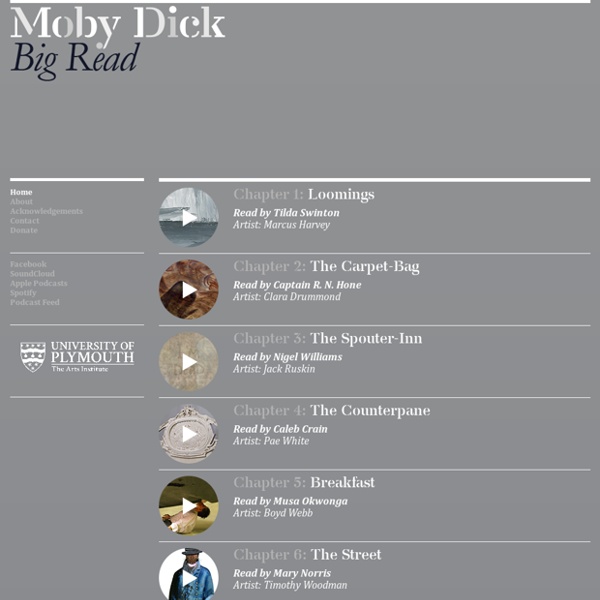



Power Moby-Dick, the Online Annotation FREE Moby Dick Book Notes The story begins with Ishmael heading out to find a whaling vessel to join. On his way to Nantucket, the first American City of whaling, he meets a harpooning savage named Queequeg, and the two become quick friends. They find their ship, the Pequod, and despite ominous warnings, and absence of the captain, they board with the rest. However, things are not what they seem, because when the head of the boat, Captain Ahab, make his first appearance, there is something troubling about him. The Pequod sails over foreign seas, in order to reach the equator, a known hangout of Moby Dick, at the right season. Finally they approach their intended destination. Moby Dick is seen at last.
Moby-Dick: Chapters 1–9 Chapter 1: Loomings The narrative of Moby-Dick begins with the famous brief sentence, “Call me Ishmael.” Ishmael, a sailor, describes a typical scene in New York City, with large groups of men gathering on their days off to contemplate the ocean and dream of a life at sea. Chapter 2: The Carpet-Bag Ishmael travels from New York to New Bedford, Massachusetts, the whaling capital of the United States. Chapter 3: The Spouter-Inn Inside the Spouter-Inn, Ishmael finds a large, somewhat inscrutable oil painting, which he finally determines to be a depiction of a whale attacking a ship. Chapter 4: The Counterpane When Queequeg and Ishmael wake up the next morning, Queequeg’s arm lies affectionately thrown over Ishmael, as if the latter were “his wife.” Chapter 5: Breakfast The Spouter-Inn’s breakfast table is filled with whalers, yet the meal, to Ishmael’s surprise, is not enlivened with sea stories or bawdiness. Chapter 6: The Street Chapter 7: The Chapel Chapter 8: The Pulpit Chapter 9: The Sermon
Comment analyser une oeuvre musicale ou un extrait sonore ? (Methodologie) - atelierdezarts Comment analyser un extrait sonore ? I. Replacer l’œuvre musicale dans son contexte. II. Les différents paramètres de la musique qui vont être détaillés ci-dessous ne sont pas forcément de même importance dans une œuvre musicale. · Le tempo et le rythme : Quelle est la vitesse (tempo) de la musique ? · La formation et les instruments : Quels instruments jouent ? · La voix : Quel est le registre (grave, aigu / soprano, basse, ténor…) ? · L’intensité et la dynamique (le volume du son) : Quel est le volume (intensité) du son ? · L’impression produite : Quel est le « caractère » de la musique (très agitée, très calme, très joyeuse…) ? · La forme et la structure : Comment s’organise le morceau de musique et quelles sont les différentes parties du morceau (introduction, coda, exposition du thème, transition, couplet, refrain, pont…) ? III. La musique et les images sont-elles synchronisées ?
Moby-Dick/Chapter 1 Call me Ishmael. Some years ago—never mind how long precisely—having little or no money in my purse, and nothing particular to interest me on shore, I thought I would sail about a little and see the watery part of the world. It is a way I have of driving off the spleen and regulating the circulation. Whenever I find myself growing grim about the mouth; whenever it is a damp, drizzly November in my soul; whenever I find myself involuntarily pausing before coffin warehouses, and bringing up the rear of every funeral I meet; and especially whenever my hypos get such an upper hand of me, that it requires a strong moral principle to prevent me from deliberately stepping into the street, and methodically knocking people’s hats off—then, I account it high time to get to sea as soon as I can. There now is your insular city of the Manhattoes, belted round by wharves as Indian isles by coral reefs—commerce surrounds it with her surf. But look! Once more. But here is an artist.
ConceptNet What is ConceptNet? [top] ConceptNet is a freely available commonsense knowledgebase and natural-language-processing toolkit which supports many practical textual-reasoning tasks over real-world documents right out-of-the-box (without additional statistical training) including topic-jisting (e.g. a news article containing the concepts, “gun,” “convenience store,” “demand money” and “make getaway” might suggest the topics “robbery” and “crime”), affect-sensing (e.g. this email is sad and angry), analogy-making (e.g. The ConceptNet knowledgebase is a semantic network presently available in two versions: concise (200,000 assertions) and full (1.6 million assertions). ConceptNet is a unique resource in that it captures a wide range of commonsense concepts and relations, such as those found in the Cyc knowledgebase, yet this knowledge is structured not as a complex and intricate logical framework, but rather as a simple, easy-to-use semantic network, like WordNet. Download ConceptNet [top]
About WordNet - WordNet - About WordNet